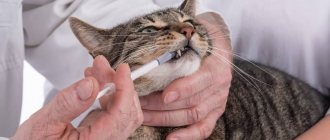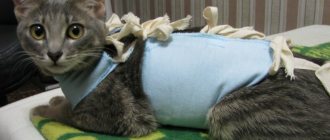Home / Cat breed / How to make a cat give birth faster
If a cat gives birth for the first time, she needs help. She needed to build a nest before giving birth. And you can’t leave her. It can get scared and hurt kittens.
If the kitten is stuck, grab the body with its head and, during contractions, rock it from side to side, gently pull it down.
If the head appears and the body is stuck, then pull the scruff of the neck, if a paw is sticking out from the head, and the second one is stuck, then carefully push the paw back
If the kitten has had enough to drink and shows no signs of life, take the kitten’s body in your hand, pressing the head with your index finger, shake it like a thermometer.
If the baby does not show signs of life or is blowing bubbles, then pull the liquid from the respiratory tract, intensively but gently rub the baby with a towel, and shake again. Childbirth is over - calcium gluconate intramuscularly 1-2 cubes - after 2-3 hours oxytocin intramuscularly or subcutaneously 0.2-0.3 ml
How should you do this if your cat and kittens are dear to you?
If the baby does not show signs of life or is blowing bubbles, then pull the liquid from the respiratory tract, intensively but gently rub the baby with a towel, and shake again. Childbirth is over - calcium gluconate intramuscularly 1-2 cubes - after 2-3 hours oxytocin intramuscularly or subcutaneously 0.2-0.3 ml
The female domestic cat reaches sexual maturity by 6–8 months of age. After this, if the owner is not going to sterilize his pet, he should be ready to give birth. But sometimes the birth of an animal is delayed, and it is necessary to stimulate it.
Pregnancy in a domestic cat is relatively quick, lasting 55 to 60 days. Some individuals give birth completely independently and human participation in this process is not important to them. British cats, Sphynxes, Maine Coons or Persians require the obligatory assistance of the owner during childbirth or even the presence of a veterinary obstetrician.
It is advisable to know exactly how much time has passed since the moment the animal was mated, in order to be prepared for the required time.
The approach of “day x” will be indicated by the so-called harbingers of childbirth, during which the expectant mother is a cat:
- begins to look for a secluded place to build a nest;
- becomes very affectionate with a person, requires special attention to himself;
- may refuse to eat;
- begins to lick the swollen mammary glands.
A few days before the expected birth, you need to prepare the necessary list of things that may be needed to help the cat and her cubs:
- Childbirth box. Place in a secluded, warm place;
- Disposable diapers and sterile wipes;
- Disposable syringes and medications if there is a possibility of complications;
- Vaseline oil;
- Sharp scissors;
- Disinfectant solution;
- Surgical or silk thread to tie the umbilical cord;
- Iodine or brilliant green.
First stage of labor
When the cat’s stomach drops and the kittens inside are shaking, there is very little time left before giving birth. A cat's labor can be divided into three main stages.
This stage can last up to 24 hours. It all starts with a decrease in the cat’s body temperature by about two degrees. The animal begins to behave restlessly and often licks under its tail. Some individuals vomit.
It is necessary to move your pet to a “nest” specially prepared for childbirth and continue to be close to her. It is advisable for any cat to give birth at home, because a familiar environment is calming and helps to reduce anxiety at this most important moment.
During the first stage of labor, your cat's water breaks, then her breathing quickens, her heart rate increases, and contractions begin. The animal begins to purr loudly and even scream. At this moment, the owner’s support in the form of soft stroking on the tummy and a calm conversation will not hurt.
Preparing for childbirth
Cats usually give birth 58-65 days after conception. Let us note that purebred cats, due to their less adaptation to natural conditions, because they were bred specifically to play the role of domestic cats, cope with childbirth with great difficulty. If you have a Persian, Sphynx or Maine Coon, then the cat will need your participation. To begin with, you need to immediately show that you are at home, you are near her, which will allow her to calm down. If we are talking about purebred cats, there is a high probability that you will need the help of a professional, so be prepared to take the veterinarian home yourself while your family is with the cat.
About a week before giving birth, the cat will choose a nest for lambing, usually this begins a week before giving birth, so you will have the opportunity to navigate. Note that this is how the due date is estimated for both regular and purebred cats. The first signal is that the cat will really demand a lot of attention, come to you more often, ask to be petted, and so on - she really needs attention and calmness, which she will strive for. Next, you need to note the process of swelling of the mammary glands, which will also clearly show you that some changes are happening to the cat. She begins to lick them more actively - the due date has approached significantly and you need to be on guard. At the second stage, you should already have everything that will be necessary for the birth itself, and this is alcohol, gloves, gauze bandages, towels, iodine and much more. Usually, for a cat, giving birth is a long process, so you need to be mentally prepared for the procedure, be sure to read stories from those people who have already helped their cats give birth and have successfully coped with this procedure.
As experts note, usually every fifth cat cannot give birth, or rather, cannot do this without at least some basic help from the owners. If you are the owner of at least a mixed breed, this will no longer require your intervention in the birth process, but owners of Persians, exotics, and British cats should know that in most cases your pet will require a cesarean section, which means that you can seek help in advance, alert the veterinarian, who will be better prepared to respond to the call.
Third stage of labor
The third stage of labor is the state of calm of the cat's uterus in the interval between the birth of babies. It lasts about fifteen minutes. During this period, the cat can drink some water. Often the cat also eats the afterbirth, which comes out after the kitten is born. But you should not allow your pet to eat more than two afterbirths. This can cause stomach upset for the new mother.
The number of placenta during childbirth in cats should be the same as the number of kittens born. If the placenta does not come out, the owner needs to help his pet remove it. If this is not done, the cat may develop serious inflammation.
It is impossible to accurately determine the duration of labor in cats, because this is a very individual process. There are individuals who cope within a couple of hours, and for some, prolonged labor lasts up to 36 hours.
When should you contact a veterinarian?
As for placentas, they should all come out within 12 hours after the end of labor. If there are fewer placentas delivered than kittens were born, then it is urgent to show the cat to a specialist.
Below is a list of situations when you and your cat will also need the help of a veterinarian:
- Premature birth. The average pregnancy rate is 51-71 days. If labor starts earlier, you should see a doctor!
- Sometimes it becomes necessary to artificially induce labor. But in each specific case, only the doctor decides HOW to do this;
- Attempts last half an hour or more, but labor never occurs;
- Vivid bleeding indicates tissue rupture. Only a doctor can solve the problem;
- If the day after giving birth the cat experiences vaginal discharge with a particularly unpleasant odor;
- If a lactating cat then develops a fever;
- If the mammary glands are inflamed and hardened;
- If the kittens are cold and hard to the touch.
Video
Helping a newborn kitten
There are cases when a cat, having just given birth to her cubs, does nothing towards them. Then the owner of the new mother must get down to business.
We recommend reading: Cat Vomits White Foam Refusal to Eat
The kitten needs to be helped to free itself from the amniotic sac and gently blow into its nose. Then squeeze the umbilical cord at a distance of a couple of centimeters from the baby, tie it with surgical thread and trim it with sterile scissors. The wound should be smeared with green paint, and the baby should be pushed towards the mother’s nipples.
When the kitten begins to eat milk, the cat's maternal instinct will take over and she will continue to take care of the offspring without the help of the owner.
To prepare for the birth of your mustachioed pet, you can read a lot of information, watch videos on the Internet and follow all kinds of advice. And if everything goes smoothly, the cat can easily give birth. But, no matter what knowledge and skills the owner of a pregnant cat has, if during childbirth there are doubts about the correctness of what is happening, it is imperative to take action and call a veterinary obstetrician. It’s better to play it safe so that everything goes well for the new mother and her cubs.
- Oxytocin. A synthesized artificial hormone that causes uterine contractions. Use only as directed by a veterinarian! If used incorrectly, the drug can cause bleeding and even rupture of the cat's cervix;
- Gamavit. A drug to stimulate the smooth muscles of the uterus. Used in difficult cases to facilitate the birth process;
- Travmatin. A remedy for pain relief and regulation of contractions and pushing. It is used to prevent complications during childbirth, as well as to heal injuries to the external genitalia of the animal and prevent the inflammatory process.
- Calcium gluconate. Gradually enhances the animal’s labor and promotes milk production. After childbirth, it is used to relieve attacks of eclampsia.
Cat, cat and kittens
If your cat goes into labor, rely on her maternal instincts. Just stay close to her and watch what happens. Only act and take action if something goes wrong.
First, make sure everything is ready for your cat to give birth. Two weeks before the expected due date, you should place a large box in an area of your home that your pregnant cat frequents. Your cat wants to have a cozy nest for her babies. Make sure the room the box is in is warm. Place paper or other material in the box that your cat can easily tear and shred. A giving birth cat will be quite happy with the paper. A blanket will also come in handy during childbirth. Other essentials include towels, clean scissors, styptics, clean thread, and antiseptic.
Keep all doors closed. Your cat should not give birth on the street!
Labor should begin no earlier than after 61 days of the cat's pregnancy. Otherwise, there is a high probability that the kittens will not survive. But if labor does not begin after 70 days, contact your veterinarian immediately.
During the last days of your cat's pregnancy, you must monitor her and her condition very carefully and closely. Here are some signs that indicate labor is about to begin:
- Temperature drop by 1° C. Normal temperature is 38.6° C.
- Restless behavior. Your cat is looking for a place to give birth.
- The appearance of milk from the nipples. Most cats have eight nipples.
Once labor begins, your cat begins to purr and breathe heavily rhythmically. Labor has begun, but it is possible that the first kitten will appear only in a few hours. The contractions will intensify. Calm your cat down, tell her kind, gentle words. It is normal for fluid and blood to start coming out of her vulva. If your cat has been having strong contractions for two hours without any signs of kittens, you should contact your veterinarian immediately! Perhaps two kittens ended up in the birth canal together and blocked the path for themselves and the others.
Eventually, the first kitten is delivered enclosed in a bag filled with liquid. The sac may burst while the kitten is emerging from the birth canal. The mother will begin to lick the kitten. Soon the newborn will breathe normally and cry for the first time, just like a human baby.
Typically, a cat chews the umbilical cord with its teeth. Only if she does not do this can you carefully cut the umbilical cord with scissors. In this case, be sure to tie the umbilical cord with a clean thread at a distance of 4 cm from the kitten’s belly and cut it off above the tied area. Lubricate the incision with an antiseptic (for example, alcohol). It is very important to do everything correctly so as not to endanger the kitten’s life. This is just one of the many things that can go wrong during childbirth. Therefore, it is extremely important that you prepare well for them.
We recommend reading: Cat Has Bad Breath
The placenta appears immediately after the kitten is born or shortly thereafter. Most often, the cat eats it. Placentas should follow the birth of each kitten. A placenta that does not come out after delivery can cause serious infections.
When the kitten is breathing well and has been licked clean by the cat, place it close to the cat's nipple. Usually he starts sucking milk right away.
Your cat won't get into trouble during and after birth if you know exactly how to recognize complications and what to do about them. If you suspect something is wrong, call your veterinarian immediately if you don’t want to lose your cat and kittens.
You can also read about cat birth here.
Eventually, the first kitten is delivered enclosed in a bag filled with liquid. The sac may burst while the kitten is emerging from the birth canal. The mother will begin to lick the kitten. Soon the newborn will breathe normally and cry for the first time, just like a human baby.
Preparing a place for a cat to give birth
Yes, you must work proactively and before the cat even thinks about which secluded place to give birth in, you simply must offer her the best option (unless, of course, you want the pet to “build a nest” on a shelf in the wardrobe or in a hard-to-reach corner under the sofa).
What can be used as a “nest” for a giving birth cat:
- exhibition cage. Some breeders offer the cat to give birth in the same cage in which the animal was previously taken to exhibitions or doctors. Let's say right away that the option is not the most suitable, since the cage will not retain internal heat, there is no privacy in it and it is not comfortable if the cat herself cannot cope with the birth of babies;
- birth box. Such a box has a hinged lid (this is a plus), an entrance for the cat (another plus) and they are convenient to place in enclosures or special rooms. You can make such a box yourself from an old bedside table;
- cube tent. One of the best options, since in such a tent it is easy to create the atmosphere the cat needs, because the tent can be closed and is quite spacious;
- but the simplest and, what’s more, the best option is a spacious cardboard box. The only things that matter here are the size and presence of ventilation holes.
Whatever version of the “nest” you choose, it must meet the basic requirements:
- The lid should open from the top. This way you will personally supervise the birth process and help if necessary;
- There must be a separate entrance for the cat. Make the entrance so that only the mother cat can use it;
- There should be a threshold at the entrance for the cat so that the kittens, as they grow up, cannot leave the “nest” on their own.
At the bottom of the “nest”, lay several layers of newspaper or oilcloth, and be sure to lay a clean diaper or sheet on top.
Then look around and try to understand what place is in your apartment:
- The calmest thing?
- Draught-free?
- Least visited by household members?
Place the box in a quiet corner and from time to time invite the pregnant cat to lie down in her new house.
Do the same if you notice that the cat is building a “nest” in a corner that you did not plan.
Setting up a nest
The birth of kittens is always a big stress for your pet. That is why it is very important to prepare the nest for birth in advance and try to accustom the animal to it. As a nest, you can use a spacious box that has a lid on top. So that the cat can easily get inside, it is necessary to cut a hole in the side. Do not place soft blankets on the bottom of the box. The best option is several layers of paper or baby diapers (they will most likely have to be thrown away).
The box should be placed in a warm, quiet and dark place where there are no drafts. Place a trash can, food and water in this room for your pet. And so the question: “How to help a giving birth cat?” Without taking you by surprise, we will tell you a little about the signs of pregnancy and the onset of labor in an animal.
How to help a cat give birth for the first time? Many people ask this question. On the day of birth, you need to be especially careful, because your pet may need help at any time.
You will definitely notice that your cat's behavior on the day of delivery has changed dramatically.
- On the day of birth, a previously calm cat begins to constantly walk around the rooms, try on the nest an infinite number of times and often lick the genitals.
- Rectal temperature drops by about 2 degrees.
- The cat's breathing quickens, and as the pain increases, she begins to purr and even scream.
- The animal's vagina swells and bloody or yellow discharge appears.
This is the first stage of labor and can last from 12 to 24 hours. You may not have to think about how to help your cat give birth to kittens, but it will be useful to support her morally (pat her belly and talk to her). Be close to your pet.
When might a cat need your help?
So, the cat gives birth for the first time. You don't know how to help. It is important to understand here that there are signs that directly indicate that the pet needs help. Here they are:
- Part of the kitten has already appeared, but it cannot be born because it is stuck.
- The emerging kitten is not breathing.
- The cat did not release the baby from the amniotic sac.
If the pet cannot bite the umbilical cord.
The afterbirth does not come out for a long time.
Attentive attitude towards the cat who has given birth, competent and careful care, providing the animal with a comfortable environment and adequate nutrition contribute to the rapid restoration of strength and the development of strong offspring.
Pregnancy and childbirth (lambing) in cats are natural processes characteristic of unsterilized pets. In most cases, they proceed without complications, but sometimes the owner’s help is required. Complications are typical for primiparous, purebred and dwarf cats, as well as for those who are sick with congenital or acquired pathologies. In such cases, mandatory provision of step-by-step assistance is required throughout the entire lambing.
How do cats give birth for the first time, what should the owner do in such a situation?
The vital activity of an animal is not only nutrition and growth, but also reproduction. Every owner should know how cats give birth for the first time in order to help an inexperienced mother. Instinctively, the animal feels what needs to be done, but the pain makes the firstborns afraid and stressed. The owner’s ability to come to the rescue in time will help save the pet’s life.
How to recognize the onset of labor
Inexperienced owners worry more than their pets. They ask in advance how to understand that a cat has started giving birth, and how long to wait for the kittens to appear. Veterinarians advise monitoring the behavior and well-being of your pet throughout pregnancy. This will help you easily recognize changes at an early stage.
Behavior of the expectant mother
The first signs of labor in a cat involve behavior. The expectant mother is nervous, anxious, constantly looking for a secluded corner and trying to build a nest. Because of this, it is important to accustom her to a prepared box in advance.
A pregnant woman's appetite decreases to the point of hunger strike. She constantly licks the external genitalia, and a few hours before lambing begins to arch her back. With a strong attachment to the owner, the animal begins to attract his attention by meowing.
We recommend reading: Surgical patch of the conjunctiva of the eye in a cat
Physiological signs
Physiological signs include swelling of the mammary glands, the appearance of lactation and a decrease in body temperature to 37 °C. The pregnant belly drops and takes on the shape of a pear. The frequency of going to the toilet increases. 1-2 days before the onset of labor, the mucous plug comes off. It is difficult to notice the passage of water, since the secreted mucus is constantly licked out.
Description of the birth process
Inexperienced owners are primarily concerned about the length of the process. The condition of newborns and their possible number are also important.
How long does labor last?
It is impossible to give an exact figure that determines how long a cat’s labor lasts. This indicator is individual. It depends on age, breed and general health. Typically the entire process takes 4-12 hours. If the duration lasts for a day, it is recommended to contact a veterinarian. A negative prognosis is typical when it reaches 48 hours. In this case, urgent surgery is required to save the animal and its offspring.
You can determine how long it will take for a cat to give birth to the next baby by looking at its order. The first two take the longest to come out. The wait may last for several hours. The birth time of the remaining kittens is a few minutes.
How many kittens can be born?
When talking about how cats give birth, it is necessary to note the size of the possible litter. On average, the number of newborns ranges from 2 to 6. Their number depends on the previous pregnancies, breed and age of the woman giving birth. A small number of newborns (1-3) is typical for primiparous, elderly and small pets.
What do newborn kittens look like?
The weight of newborns is 80-120 g, and their body length is 9-12 cm. They are born deprived of sight and hearing, so they really need help from their mother or a person. At first, they sleep constantly and eat a lot. Due to fragile bones, babies cannot stand on their feet. They navigate with the help of a developed sense of smell and touch and use a thin squeak to communicate. At first it is better not to touch them. It is enough to monitor their weight.
How to determine the end of a process
The absence of contractions for 2 hours indicates the end of labor. Full recovery of the body takes 2 weeks. During this time, newborns grow up and become more independent.
Duration of labor
It is difficult to give an exact answer as to how long labor lasts for a cat. Depending on heredity, belonging to a particular breed, physical condition, age and individual characteristics of the body, cats can give birth from several hours to a day and a half. The owner cannot know in advance how long the cat will give birth, so he should be prepared for both easy, quick labor and long contractions and painful pushing that last for 24-36 hours. In this case, childbirth is usually divided into several stages.
The first stage - contractions
Childbirth begins with contractions of the uterus. This physiological process is accompanied by colorless vaginal discharge. As the first stage comes to an end, the owner may notice that the cat's contractions are becoming more frequent and pronounced. In this case, the animal may breathe heavily and make hoarse sounds.
The second stage - the birth of kittens
At the second stage, the owner may notice that the cat’s water has broken; how long it will take for the pet to give birth is still unknown, however, during a normal birth, no more than two hours should pass between the rupture of the amniotic sac and the birth of the kittens. If after this time labor does not begin, you should call the veterinary clinic and call a specialist.
During the second stage, the cat must give birth to kittens and gnaw their umbilical cords. If the pet does not do this, the owner will have to take on the role of “obstetrician”. He will need to carefully cut the umbilical cord. Next, you should treat the wound with an antiseptic. If necessary, the owner must release the kitten from the shell, wipe it with a clean towel and free the oral cavity and nasal passages from mucus.
How to deliver babies of varying degrees of complexity at home
Assistance to the woman in labor depends on the severity of the lambing. It is impossible to predict its outcome in advance, so you will have to act according to the situation.
Lungs
For mild lambing, no intervention is required. You just need to ensure the safety of newborns. During labor, the mother may crush them, so place the kittens in a separate box until the last baby appears.
Compare the number of newborns and placenta. The lack of placenta is caused by getting stuck inside the womb, leading to inflammation. You will have to remove it yourself by wrapping your fingers in a clean bandage. If pus, mucus or blood appears, lambing is considered moderate or severe.
Average
At the end of labor, the new mother independently gnaws the umbilical cord, eats the afterbirth and cleanses the newborns of mucus. If she did not do this, you will have to play the role of an obstetrician. Carefully cut the umbilical cord 4 cm from the abdomen, tie it with thread and treat the wound with an antiseptic.
Before cutting the umbilical cord, remove membranes from each kitten and clean their nasal passages and mouth using a pipette or bulb. If there is no breathing or a characteristic squeak, carefully fold the baby in half, rub him with a towel and gently shake him upside down.
Do not give your pet more than two afterbirths. They are rich in beneficial microelements and have a beneficial effect on the immune system, but cause gastric upsets if consumed in excess. If the bubble does not burst inside the vagina, the pet may try to burst it along with the kitten. Discourage this action by noticing a bubble emerging from the vagina. After the newborn arrives, carefully open the amniotic sac, being careful not to touch the tiny body.
How to help your cat give birth
During childbirth, the cat breathes heavily, moans, meows... As we have already mentioned, in most cases, only one thing is required from the owner during childbirth - to console and reassure. But there are situations when human intervention can save the life of both newborns and the cat itself. And here it is important to know what to do in emergency situations.
So, the kitten was born, but the amniotic sac did not burst on its own and the cat did not rupture it.
What to do, how to help a cat during childbirth?
- burst the bubble under the kitten's nose;
- Take the baby in your palm, press it a little with your fingers and shake it. If there is no reaction, use a small syringe to remove liquid from the respiratory tract;
- rub with a clean cloth;
- shake again;
- Offer the kitten to the cat so that she can lick the baby.
If the kitten does not show signs of life, this does not mean that it is stillborn. Hold the kitten upside down (not by the paws!) - this stimulates breathing.
Try to place the baby who had to be resuscitated in this way more often near the mother cat.
What to do if the kitten gets stuck while pushing? To independently deliver a cat and extract a kitten:
- put on rubber gloves and lubricate the cat’s vagina with Vaseline;
- take a clean cloth and, grasping the kitten’s body, gently pull it down, rocking the kitten from side to side. You can't pull on limbs!
What to do if the cat does not have milk for kittens or she abandons them.
What not to do when giving birth to a cat
- human antiseptics cannot be used;
- Do not pull kittens by the paws;
- the cat should not be allowed to eat more than two placentas;
- do not hold newborn kittens in your arms during the first hours;
- do not turn on bright lights in the room where the babies now live (this can lead to cataracts);
- Don’t panic – everything will go according to plan if you’ve prepared thoroughly!











